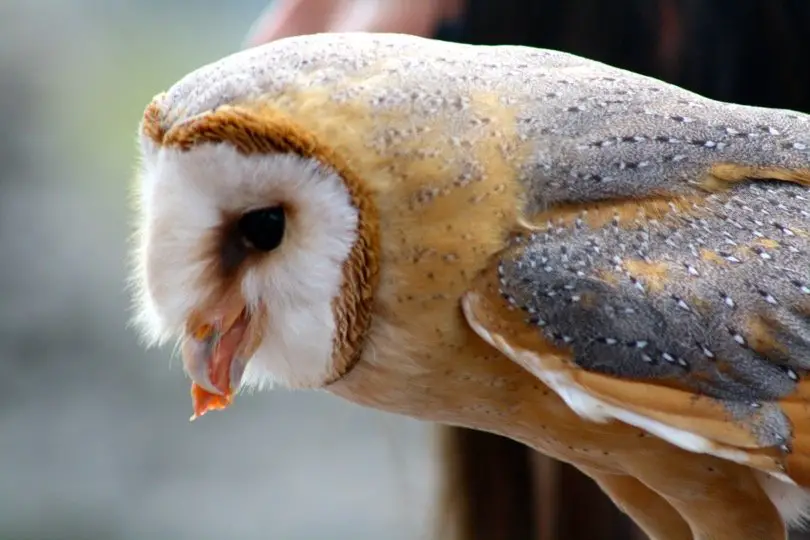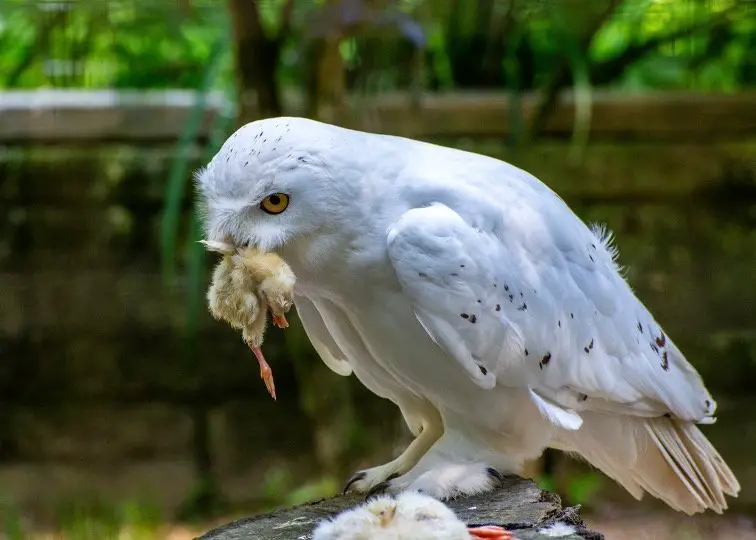What Do Owls Eat?
Owls have exceptional hunting skills. Owls are exclusively carnivorous, feeding on everything from minute insects to huge mammals and birds.
Their diet depends on various species. This is owing to their distinct habitats, which provide them with a distinct climate and geographical location.
This article gives a brief overview of some of the owl’s favorite foods.
1. Small Insects
Owls can consume numerous sorts of insects, including leaches, pillbugs, earthworms, moths, snails, crickets, cicadas, centipedes, beetles, millipedes, spiders, and grasshoppers.
2. Small Mammals
Owls capture and consume a wide variety of tiny animals. They enjoy hunting hares, marmots, chipmunks, mice, ducks, rats, bats, rabbits, raccoons, skunks, shrews, voles, and squirrels tremendously.
Young of larger species, including prairie dogs, foxes, cats, porcupines, and others may also be preyed upon by the owls.
3. Amphibians
Owls capture and consume numerous amphibians. Owls eat amphibians like frogs, lungless salamanders, newts, mole salamanders, toads, and treefrogs.
4. Reptiles
Owls enjoy consuming a range of lizard species, including swifts, skinks, geckos, and anoles. In general, owls will capture and consume any species of lizard they can locate.
Typically, owls target blind snakes that are smaller or non-venomous, like ground snakes, garter snakes, and earth snakes.
5. Birds
Owls have an advantage over other bird species due to their capability to perceive in dim light and detect in the dark. They kill and consume a vast array of different species of birds.
They enjoy hunting as well as capturing sparrows, pigeons, cuckoos, mockingbirds, swallows, warblers, jays, doves, creepers, woodpeckers, thrushes, tits, flycatchers, waxwings, finches, starlings, falcons, and even shorebirds.
In spite of the fact that they consume other birds, owls cannot be considered as cannibals. They may consume lesser species of owls however they often stay away from larger owls.
It does occur on sometimes for certain owls to become cannibals, but whether this is due to stress or an accident is unknown.
6. Lemmings
Throughout the year, mature snowy owls consume a vast quantity of lemmings. In reality, an adult snowy owl can consume over 1,500 lemmings in a single year.
7. Fish
Sometimes, owls hunt and consume fish, however not all owl species are capable of hunting and catching fish. The most frequent fish species captured by owls include catfish, minnows, sunfish, crabs, silversides, and shad.
Diets of Owls Species
The majority of an owl’s active time is spent hunting for food.
Various types of owls have distinct diets. Let us have a look at the diets of different owls.
1. Asian and African Owls
Asian and African Owls are particularly skilled in catching fish for food when it comes to marine life.
2. Barn Owls
Barn Owls consume young mice and voles. It has been observed that the barn owl mostly feeds on mice, rats, voles, lemmings, and insects. The barn owl occasionally preys upon blackbirds, starlings, and meadowlarks.
They also eat a wide variety of insects. Occasionally, they will also consume fish, reptiles, amphibians, and birds. Barn owls graze on cotton rats, although in their western habitats they prefer pocket gofers.
House mice and Norwegian rats are also favoured snacks. In addition to hunting rodents, barn owls also hunt shrews, bats, birds and rabbits.
3. Screech Owls
The diet of the screech owl ranges from small insects and other invertebrates to mammals, birds, and reptiles of considerable size. Screech Owls typically consume young insects.
4. Eagle Owls
Eagle Owls typically hunt young foxes, hares, and sometimes other birds as well.
5. Snowy owl
The primary components of a snowy owl’s food include animals, such as hares, lemmings, and birds, such as geese and songbirds. Snowy owl may spend considerable time attempting to capture lemmings. These owls capture them three to five times per day.
6. Burrowing Owl
The burrowing owl’s favourite meal is small insects such as grasshoppers and beetles, but it will also eat small to medium-sized mammals such as voles, squirrels, and more. In the south, the preferred foods of burrowing owls are grasshoppers, beetles, voles, and squirrels.
7. Great Horned owl
The great horned owl is a carnivorous bird. The majority of the great horned owl’s diet consists of medium-sized animals, such as skunks, hares, and geese. Great Horned Owl likes mammals, waterfowls, geese, mice, skunks and voles, etc.
Great horned owls do not appreciate fish, but they occasionally find skunks appetizing enough to consume. The great horned owl is renowned for being the only species that enjoys consuming skunks on a regular basis.
The diet of great horned owls includes geese, crows, other raptors, amphibians, and reptiles, but small mammals such as hares and rabbits are their preferred food source.
You may also like to read Baby Owl: All The Facts, Care, and Pictures
8. Fish Owls
Fish owls in Asia and Africa hunt fish, amphibians, and other aquatic animals.
9. African Grass Owl
The African Grass owl favors rodents, birds, big invertebrates, and bats for food.
10. Saw-whet Owl
The majority of the northern saw-whet owl’s diet consists of small mammals like shrews, moles, and mice. It also consumes birds, insects, and intertidal invertebrates, such as isopods, to augment its diet.
11. Long-eared Owl
Primarily, the long-eared owl feeds on tiny rodents. Wintertime diet consists of tiny birds.
12. Elf Owl
The elf owl, the world’s tiniest owl, primarily consumes insects, whereas the great grey owl, one of the largest owls, primarily consumes small mammals such as mice.
13. Barred Owl
The barred owl’s diet is extraordinarily diverse; they consume nearly every kind of animal in the kingdom Animalia, including mammals, reptiles, birds, amphibians, fish, and invertebrates.
Typically, owls capture a living animal, kill it, and then consume it. It is not typical for these birds to swallow dirt, sand, or leftovers while
They are unfortunately susceptible to ingesting microfibers and microplastic fragments, which are microscopic particles of plastic trash. One owl can reportedly consume hundreds of bits of polyester, nylon, and polypropylene per day.
Microfibers from synthetic clothing and ropes account for 86% of all plastics consumed by owls and other birds of prey, according to a research. In most cases, they originate from washing machines.
To save the owls, we should not through plastic on the ground and in jungles.

